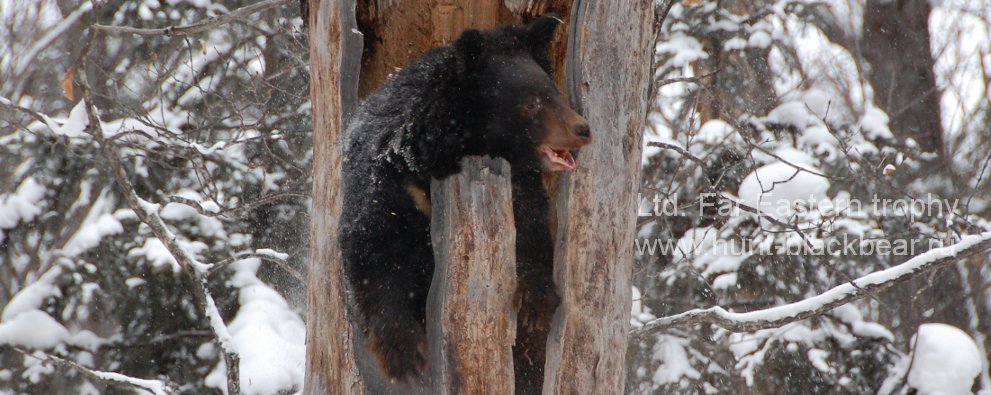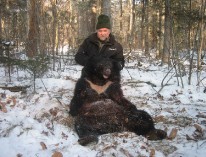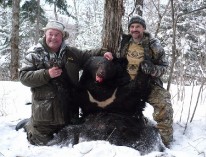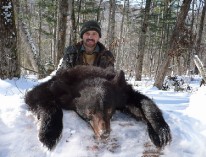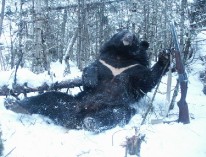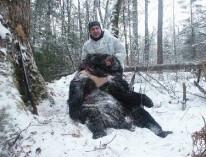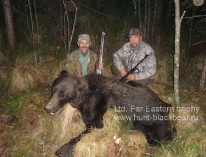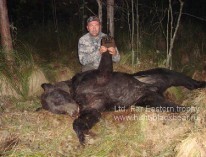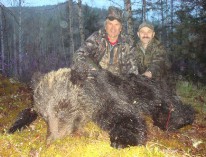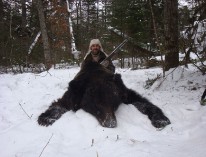Hunting, Fishing and Nature Tourism in the Russian Far East
Hunting in the Russian Far East
It is very strange and unusual to watch such mixed forms representing North and South. It concerns plant and animal world. The most amazing are fir tree with grapes twined around, cork tree and Manchurian walnut tree alongside with cedar and silver fir. A hound traces a bear or a sable. And here you may come across a tiger being very huge in size and strong like tigers in Bengal.
N .M. Przhevalsky
The Khabarovsk Territory is located in the Russian Far East. It stretches along the Tatar Strait and the Okhotsk Sea. It is rich in the variety of trees and bushes, Northern and Southern plants, growing alongside with each other. The flat territory stretches from banks of the majestic Amur River with numerous lakes and tributaries to Sikhote-Alin mountain range with the purest mountain rivers.

Broad leaved cedar with lianas of grape, kolomikta actinidia and Chinese magnolia vine (Schizandra chinensis) are very beautiful. Since the time immemorial minorities have been hunting and fishing to satisfy their needs. Today one can enjoy amateurish, sport and trophy hunting.
Himalaya (white chest) bear. Amur Brown bear
Himalaya or white chest bear has been a subtype (species) which is defined as the Ussuri tree bear (Selenarctos tibetanus ussuricus Heude). It has other names – Asiatic black bear, white-chest, Himalaya, black Tibet bear, black Himalaya bear.
Amur Brown bear has a subtype (species) which is defined as the Ussuri bear (Ursus ussuricus Heude). It also has another name – the Amur brown bear. It differs from other representatives of brown bears in the European part of Russia, Kamchatka and Sakhalin due to its prolonged skull, large teeth and black or dark brown skin.
These bears inhabit the southern part of the Far East, the Khabarovsk and the Primorsky Territories. Hunting is allowed officially and they are unique trophies.
You are welcome to hunting:
Spring season bear hunting – from March, 21 till June, 10;
Autumn-winter season bear hunting – from August, 1 till November, 30.
Methods of hunting:
- From tree stands – from the tree having ambush place not far from feed ground. Bears regularly attend it.
- Approaching method to the feed place with a great amount of bird-cherry trees growing;
- During autumn-winter season hunting is carried out by the method of approaching feed place where bears eat nuts and acorns and “on the den”. Hunting period “on the den” is limited; it lasts till November, 30.
Hunting “on the den” is accessible from April, 1 till April, 10, when a bear leaves its den after winter hibernation. So, plan such hunting in advance and reserve your tour. In all cases a hunter needs patience to get a trophy and shooting skills.
Bird-cherry tree Maaka (Padus maakii) is one of the unique beautiful low fruit trees growing in the Far East. It is a tree of 10-15 meters height with orange-yellow bark, reminding birch bark. It blooms at the end of May and in June. Flowers are smack and white, 5-8 centimeters. Fruits are small. Having ripened, fruits acquire dark violet color and bitter taste. The period of ripening is August; fruits remain on trees till September.
In the Far East it grows in the Khabarovsk and the Primorsky Territories along roads and other light places. Ripe fruits are eaten by birds and bears. Due to this very often Padus maakii is called bear’s bird-cherry tree. Fruits are not suitable for people. Bears use fruits of Padus maakii as food during the period of its ripening in August and sometimes in September. To get food bears climb the trees and break their branches.
Bare branches are used by bears for making constructions among trees reminding nests where they enjoy themselves. Numerous “bear nests” prove the importance of bird-cherry Maaka tree in the life of bears. So local hunters are successfully hunting bears during the period of fruit ripening by using approaching or ambush method. The photos illustrate “bear nests”.


Winter season hunting “on the den” is very attractive. As a rule Himalaya bear’s den is located in the stem of a big tree, usually they are lindens and cedars. Entry to the den is at the height of 2 or more meters and sometimes in the roots of a tree.
The method of hunting depends on how and when a bear leaves its den. Sometimes a bear leaves its den very slowly, and sometimes very quickly. It is necessary to have enough skill to make the accurate shot and get a trophy. It’s a very exciting moment.
Himalaya, Amur brown bear hunting is allowed strictly in accordance with a license, the number of which is limited. The earliest and latest periods of hunting must be clarified individually every season.
Hunting is a very serious process and demands preparation. So reserve trophy bear hunting beforehand.
To be sure in providing a hunting tour it is necessary to make order with reservation.
Send your application to e-mail info@hunt-blackbear.ru or fill in and send an application form from our site and make prepayment of 50% of the tour cost.
